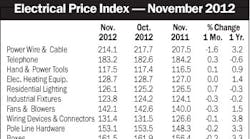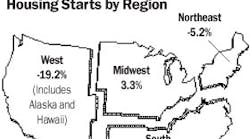Latest from Mag
People - Dec 21, 2012
Obituaries - Dec 21, 2012
November EPI Index Shows No Change
Housing Starts Dip 4% in November
Electrical Marketing - December 21, 2012
Around the Industry - Dec 21, 2012
Along with offering a status check on the adoption of LED lighting systems, the Department of Energy’s three-day Solid-State Lighting Market Introduction Workshop provided more than 250 lighting professionals with a three-day immersion into the practical application, science and art of LED lighting systems.
Held July 13-15 in Chicago, the conference agenda touched upon a wide range of topics of critical importance to a segment of the lighting market that has captured the imagination of lighting professionals. Included on the agenda at the workshops were panel discussions on LED lighting standards, marketing, reliability, design and cost effectiveness.
The diverse backgrounds of the panel participants reflected just how broadly the LED movement has already touched not only the lighting industry but municipalities, Fortune 500 companies, small businesses and utilities. For instance, executives from Home Depot and Grainger talked about their early experiences in selling LEDs; representatives from the cities of Oakland and San Marcos, Calif., and Anchorage, Alaska, presented case studies on their LED street lighting retrofits; a senior executive from Wal-Mart spoke about a successful parking lot implementation of LEDs at a store prototype in Leavenworth, Kan., and a lighting designer from Arkansas gave attendees a glimpse of a LED retrofit of a McDonald’s in Cary, N.C.
While LEDs are not yet cost-effective solutions for general-purpose lighting such as office lighting or most residential applications, panelists offered plenty of examples of how LEDs can offer attractive returns on investment and superior lighting quality when compared to traditional lighting systems. Cove lighting systems, freezer lighting and parkway and roadway lighting were mentioned most frequently at the workshop as being prime applications for today’s generation of LED lighting, but panelists and attendees agreed that it’s just a matter of time — by some estimates only three to five years— before LED technology becomes cost-effective for more general-purpose lighting applications.
James Brodrick, who manages the DOE’s solid-state lighting effort and has quickly become one of the leaders in the LED movement, was emcee for the event. He has helped the DOE become a central player in the LED industry by collaborating with manufacturers, allied trade associations, electric utilities and stakeholders in the lighting standards process such as the Illuminating Engineering Society of North America and the National Electrical Manufacturers Association (NEMA), Rosslyn, Va. Key to the DOE’s efforts in championing LED and solid-state lighting have been its efforts in promoting a bevy of stringent performance criteria including the LM-79-08 lighting standard and the EnergyStar program; the Caliper testing program that provides independent testing of new LED products; the LightingFacts product labeling program; the Next Generation Lighting (NGL) Luminaires design competition; the L-Prize competition for the design of replacements for 60W incandescent and PAR 38 lamps; the DOE Gateway program that showcases LED lighting systems in commercial and residential applications; federal funding for LED research; and robust educational efforts available online and through semi-annual workshops.
A big part of DOE’s efforts in helping to introduce LEDs to the mainstream lighting market is to not repeat the mistakes that the lighting industry made in introducing compact fluorescent lamps in the late 1980s. Brodrick and other speakers at the DOE LED workshop said many of the early CFLs that hit the market had poor light quality, were not dimmable and were unreliable. These stumbling blocks delayed the general acceptance of CFLs for years, and Brodrick does not want LED manufacturers to make the same mistake. “The last thing we want is for bad products to get out there and put us several years behind the market adoption process,” he said. “CFLs lost at least a decade in getting to the market. We are studying what went wrong.”
LED proponents don’t want to repeat the mistakes made with CFLs, and several of the panelists weren’t afraid to bash CFLs as an ineffective lighting technology with dangerous environmental side effects because of the small amounts of mercury each lamp contains. That being said, LEDs will have their own challenges before they become widely accepted. Brodrick and other panelists acknowledged the amount of bogus product performance claims in the market put out by some vendors new to the LED industry and the fact that many manufacturers’ LEDs — in some cases more than 50 percent – did not pass the DOE’s rigorous Caliper testing program. What’s equally disconcerting about the test results is that these are only the products actually submitted for testing, and many LED vendors have not yet submitted their products.
Several key takeaways from the conference included the importance of looking at all the components in a LED lighting system (including the driver, heat sink, optics and light fixture) and not just focusing on the LED itself, and the importance of measuring the total amount of light produced by a LED luminaire in an actual application and not relying on manufacturers’ test data because of the impact of lumen depreciation, heat, vibration, mounting height and many other specific application parameters.
Avraham Mor, a lighting designer with LightSwitch Architectural, a Chicago-based lighting design firm, offered a real-world perspective on LED progress, as his firm designed the LED lighting system for
theWit, a Doubletree Hotel that just opened in Chicago on July 15. Mor said lighting professionals must realize that in any LED installation they may run into challenges in meeting electrical code requirements, supply issues with electrical distributors and lighting reps selling the LED product lines, and training issues with electrical contractors who are not yet familiar with LED technology.
—Jim Lucy in Chicago

